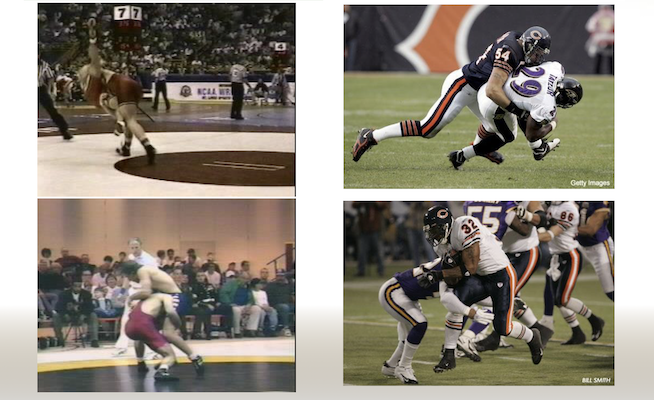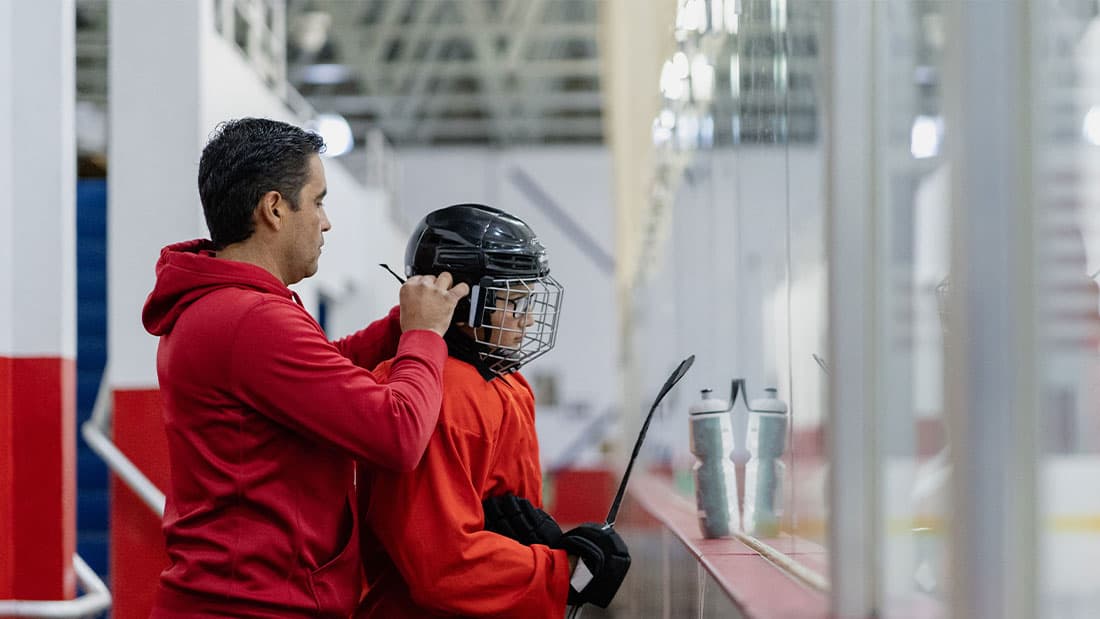Why Wrestlers Make Awesome Football Players
John Madden once said he wished all his offensive linemen had a wrestling background.
For good reason.
While the connection between football and sports like basketball and track has been highly publicized, it’s hard to argue the transferable benefits of wrestling aren’t equally (if not more so) robust.
NFL stars with prolific wrestling backgrounds include Ray Lewis, Ronnie Lott, Willie Roaf, Jonathan Ogden, Lorenzo Neal, Jeff Saturday and Roddy White.
According to Hudl, roughly 5% of all NFL Hall of Fame inductees wrestled in high school and/or college.
While the benefit might be most obvious for linemen, wrestling has crossover for just about any position.
Physically, it builds a very special type of strength that’s extremely applicable to football—the strength needed to both move an unwilling opponent and to escape an opponent attempting to exert their will on you.
Getting better at that simple ability involves so many sub-skills essential to football. As in football, just a few inches of difference in the position of your hands, feet or hips on the wrestling mat can make all the difference. Wrestling helps athletes enhance their leverage, flexibility, quickness, power and balance in ways that directly translate to football.
“Wrestling is still one of the reasons why I swivel my hips; it’s been everything for me,” 10-time All-Pro linebacker Ray Lewis, who was a Florida Class 4A state champion wrestler in high school, told Penn Live in 2010.
“The principles that you learn in wrestling, none of that changes (in football). It carries over, and if you stick to those things, the low man always wins. [Wrestling] teaches you what most people want to do, which is make your hips and butt work for you…You always want to go low; you never want to walk up to an opponent standing up. Everything has to be engaged. You have to be locked and loaded. That is what makes you shift so easy. Football is that natural shoot and tackle.”
This fantastic PDF includes several visual comparisons of positions commonly encountered in both wrestling and football:


At the University of Alabama, Quinnen Williams (now a rookie for the New York Jets) worked hard to emulate the incredibly efficient technique of his older teammate Dalvin Tomlinson (now with the New York Giants). Williams believed Tomlinson’s wrestling background (he was a three-time Georgia heavyweight state champion in high school) is part of what made him so good.
“(Dalvin) wasn’t the fastest guy, he wasn’t the strongest guy, but his technique was amazing. He was a technician,” Williams told STACK. “He wasted no energy because of the technique of it. It was amazing for me to see that.”
Buffalo Bills second-year defensive tackle Harrison Phillips was one of the most productive players in the history of Stanford football, wrangling up 103 tackles and 17 tackles for loss his senior year en rout to third-team All-America honors. Thanks to a strong wrestling background that includes three Nebraska Class A state championships, he feels as if he’s never out of a play.
“There were so many positions that (my college) coaches would just cringe at—’You have one foot in the ground, one hand over your head, the other foot is almost doing the split. Doesn’t that hurt?’ I’m like, ‘No, I feel comfortable there,'” Phillips told STACK in 2018. “Then they let the play roll and I swim off the block and make a tackle. Just going from these bizarre positions where I felt comfortable, and that was completely due to wrestling. All the scrambling and weird situations and core strength it requires, I felt comfortable in positions most people didn’t.”
Wrestling is also a tremendous endurance-builder for football players.
The typical football play lasts five seconds. One period of a high school wrestling match lasts two minutes. Wrestling shape is totally different than football shape, and it can make staying on the field for a long drive feel like a breeze by comparison.
But for all the physical benefits of the sport, the mental edge it can provide may be even more valuable.
“I think you learn more from wrestling than any other sport,” Minnesota Vikings head coach Mike Zimmer, himself an all-conference wrestler in high school, told USA Wrestling. “You find out so much more about yourself and about competition. When it gets down to it, it’s you and the guy across from you. When I was wrestling, for the six minutes that you’re out there, it is one of the toughest, most demanding sports that I’ve ever been around. I think guys that can go through that and compete with all the different things going on, it really defines who you are.”
There’s no doubt about it—wrestlers are tough, competitive people. They know how to be accountable and take responsibility, and how to dig deep when the going gets tough.
“The competitive nature, work ethic and mentality of the sport are all prized by football recruiters,” says Mark Branstad, founder and CEO of Tracking Football, a scouting service that helps teams quantify prospects’ athleticism based in part on their results/participation in multiple high school sports.
While wrestling’s carryover to linemen play might be most obvious, the sport’s a beneficial cross-training option for skill positions, as well.
“Wrestling makes you a better football player,” four-time Pro Bowl receiver Roddy White, who was a two-time South Carolina state champion wrestler in high school, told USA Today in 2011. “It is a great sport for discipline and it breeds toughness…It helped me tremendously.”
Phillips believes there isn’t a position on the field that wouldn’t benefit from wrestling.
“If you want to think of it simply, it’s just another training style. You’re working on getting stronger, having a stronger core, having better balance…if you’re a receiver who wrestled in high school, he’ll know how to block. The best safeties I ever played with in high school were wrestlers, because they knew how to come down and hit somebody with a blast double and really lay the wood,” Phillips says.
“Shoot, even quarterbacks—shoulder strength, being able to rotate with your hips, all the footwork. So much of wrestling is just footwork, and every single football position deals with footwork.”
The fact it’ll make an athlete that much more attractive to college recruiters is just icing on the cake.
“The value of playing other sports is so underrated. Anybody that I talk to that knows anything about athletics feels the same way,” says Iowa head coach Kirk Ferentz, who at times this season has utilized an offensive line where every starter could claim a finish of third place or better in their respective high school state wrestling tournaments. “The more diverse you can be, the better.”
Many youth and high school football coaches are now integrating wrestling-style drills into their team warm-ups to help their players get the benefit of training in the world’s oldest sport.
Photo Credit: 4×6/iStock
READ MORE:
RECOMMENDED FOR YOU
MOST POPULAR
Why Wrestlers Make Awesome Football Players
John Madden once said he wished all his offensive linemen had a wrestling background.
For good reason.
While the connection between football and sports like basketball and track has been highly publicized, it’s hard to argue the transferable benefits of wrestling aren’t equally (if not more so) robust.
NFL stars with prolific wrestling backgrounds include Ray Lewis, Ronnie Lott, Willie Roaf, Jonathan Ogden, Lorenzo Neal, Jeff Saturday and Roddy White.
According to Hudl, roughly 5% of all NFL Hall of Fame inductees wrestled in high school and/or college.
While the benefit might be most obvious for linemen, wrestling has crossover for just about any position.
Physically, it builds a very special type of strength that’s extremely applicable to football—the strength needed to both move an unwilling opponent and to escape an opponent attempting to exert their will on you.
Getting better at that simple ability involves so many sub-skills essential to football. As in football, just a few inches of difference in the position of your hands, feet or hips on the wrestling mat can make all the difference. Wrestling helps athletes enhance their leverage, flexibility, quickness, power and balance in ways that directly translate to football.
“Wrestling is still one of the reasons why I swivel my hips; it’s been everything for me,” 10-time All-Pro linebacker Ray Lewis, who was a Florida Class 4A state champion wrestler in high school, told Penn Live in 2010.
“The principles that you learn in wrestling, none of that changes (in football). It carries over, and if you stick to those things, the low man always wins. [Wrestling] teaches you what most people want to do, which is make your hips and butt work for you…You always want to go low; you never want to walk up to an opponent standing up. Everything has to be engaged. You have to be locked and loaded. That is what makes you shift so easy. Football is that natural shoot and tackle.”
This fantastic PDF includes several visual comparisons of positions commonly encountered in both wrestling and football:


At the University of Alabama, Quinnen Williams (now a rookie for the New York Jets) worked hard to emulate the incredibly efficient technique of his older teammate Dalvin Tomlinson (now with the New York Giants). Williams believed Tomlinson’s wrestling background (he was a three-time Georgia heavyweight state champion in high school) is part of what made him so good.
“(Dalvin) wasn’t the fastest guy, he wasn’t the strongest guy, but his technique was amazing. He was a technician,” Williams told STACK. “He wasted no energy because of the technique of it. It was amazing for me to see that.”
Buffalo Bills second-year defensive tackle Harrison Phillips was one of the most productive players in the history of Stanford football, wrangling up 103 tackles and 17 tackles for loss his senior year en rout to third-team All-America honors. Thanks to a strong wrestling background that includes three Nebraska Class A state championships, he feels as if he’s never out of a play.
“There were so many positions that (my college) coaches would just cringe at—’You have one foot in the ground, one hand over your head, the other foot is almost doing the split. Doesn’t that hurt?’ I’m like, ‘No, I feel comfortable there,'” Phillips told STACK in 2018. “Then they let the play roll and I swim off the block and make a tackle. Just going from these bizarre positions where I felt comfortable, and that was completely due to wrestling. All the scrambling and weird situations and core strength it requires, I felt comfortable in positions most people didn’t.”
Wrestling is also a tremendous endurance-builder for football players.
The typical football play lasts five seconds. One period of a high school wrestling match lasts two minutes. Wrestling shape is totally different than football shape, and it can make staying on the field for a long drive feel like a breeze by comparison.
But for all the physical benefits of the sport, the mental edge it can provide may be even more valuable.
“I think you learn more from wrestling than any other sport,” Minnesota Vikings head coach Mike Zimmer, himself an all-conference wrestler in high school, told USA Wrestling. “You find out so much more about yourself and about competition. When it gets down to it, it’s you and the guy across from you. When I was wrestling, for the six minutes that you’re out there, it is one of the toughest, most demanding sports that I’ve ever been around. I think guys that can go through that and compete with all the different things going on, it really defines who you are.”
There’s no doubt about it—wrestlers are tough, competitive people. They know how to be accountable and take responsibility, and how to dig deep when the going gets tough.
“The competitive nature, work ethic and mentality of the sport are all prized by football recruiters,” says Mark Branstad, founder and CEO of Tracking Football, a scouting service that helps teams quantify prospects’ athleticism based in part on their results/participation in multiple high school sports.
While wrestling’s carryover to linemen play might be most obvious, the sport’s a beneficial cross-training option for skill positions, as well.
“Wrestling makes you a better football player,” four-time Pro Bowl receiver Roddy White, who was a two-time South Carolina state champion wrestler in high school, told USA Today in 2011. “It is a great sport for discipline and it breeds toughness…It helped me tremendously.”
Phillips believes there isn’t a position on the field that wouldn’t benefit from wrestling.
“If you want to think of it simply, it’s just another training style. You’re working on getting stronger, having a stronger core, having better balance…if you’re a receiver who wrestled in high school, he’ll know how to block. The best safeties I ever played with in high school were wrestlers, because they knew how to come down and hit somebody with a blast double and really lay the wood,” Phillips says.
“Shoot, even quarterbacks—shoulder strength, being able to rotate with your hips, all the footwork. So much of wrestling is just footwork, and every single football position deals with footwork.”
The fact it’ll make an athlete that much more attractive to college recruiters is just icing on the cake.
“The value of playing other sports is so underrated. Anybody that I talk to that knows anything about athletics feels the same way,” says Iowa head coach Kirk Ferentz, who at times this season has utilized an offensive line where every starter could claim a finish of third place or better in their respective high school state wrestling tournaments. “The more diverse you can be, the better.”
Many youth and high school football coaches are now integrating wrestling-style drills into their team warm-ups to help their players get the benefit of training in the world’s oldest sport.
Photo Credit: 4×6/iStock
READ MORE:










